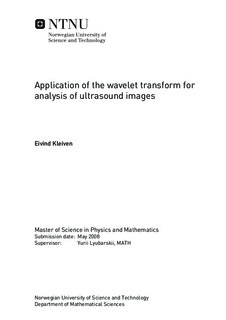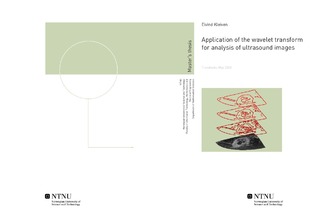| dc.contributor.advisor | Lyubarskii, Yurii | nb_NO |
| dc.contributor.author | Kleiven, Eivind | nb_NO |
| dc.date.accessioned | 2014-12-19T13:57:55Z | |
| dc.date.available | 2014-12-19T13:57:55Z | |
| dc.date.created | 2010-09-04 | nb_NO |
| dc.date.issued | 2008 | nb_NO |
| dc.identifier | 348594 | nb_NO |
| dc.identifier | ntnudaim:3810 | nb_NO |
| dc.identifier.uri | http://hdl.handle.net/11250/258409 | |
| dc.description.abstract | In this master thesis we analyse medical ultrasound images using the wavelet transform. Mathematical theory is introduced for both one-dimensional and two-dimensional functions. Three edge detectors based on the mathematical theory introduced are given. Two of the three edge detectors are suggested by the author and one is an implementation of a known edge detector called the Canny edge detector. Our implementation will differ slightly from the original Canny edge detector since in our implementation we use the wavelet transform. All three edge detectors are applied on several images and the result is discussed. The multiscale behavior of the wavelet transform makes it usefull for edge detection. For small scales it is sensitive to noise, but with good localisation of edges. For large scales it is not as sensitive to noise, but with poorer localisation. One problem when designing an edge detector is to find the scale that have the best trade-off between localisation and noise sensitivity. We suggest an algorithm that automatic selects this scale using information from the wavelet transform across larger scales. The result is an algorithm that works satisfactorily for a set of images that differs in amount of noise and contrast between objects in the image. An edge detector for one-dimensinal signals are given. This edge detector works very well for locating singularities and characterising Lipschitz regularity in one-dimensional signals. However, as an edge detector for images it does not function satisfactorily. Further investigation should be done on how to use the multiscale information carried by the wavelet transform. The author are convinced that better edge detectors that are less sensitive to noise with good localisation properites can be derived using the wavelet transform across scales. | nb_NO |
| dc.language | eng | nb_NO |
| dc.publisher | Institutt for matematiske fag | nb_NO |
| dc.subject | ntnudaim | no_NO |
| dc.subject | SIF3 fysikk og matematikk | no_NO |
| dc.subject | Industriell matematikk | no_NO |
| dc.title | Application of the wavelet transform for analysis of ultrasound images | nb_NO |
| dc.type | Master thesis | nb_NO |
| dc.source.pagenumber | 87 | nb_NO |
| dc.contributor.department | Norges teknisk-naturvitenskapelige universitet, Fakultet for informasjonsteknologi, matematikk og elektroteknikk, Institutt for matematiske fag | nb_NO |

